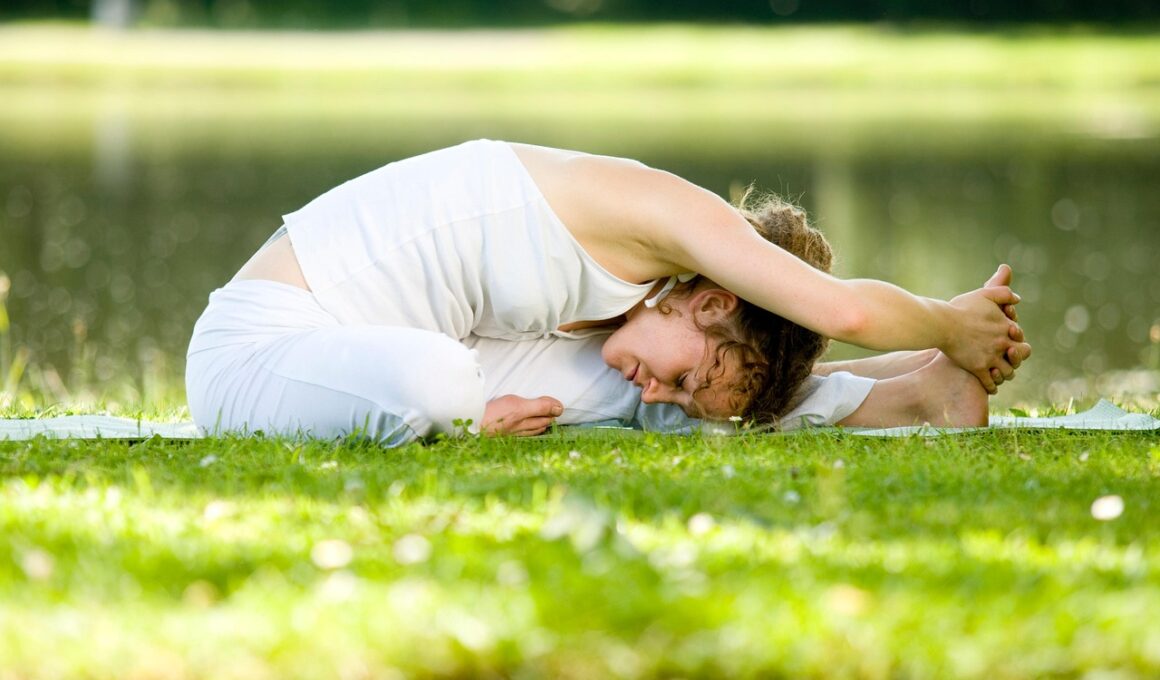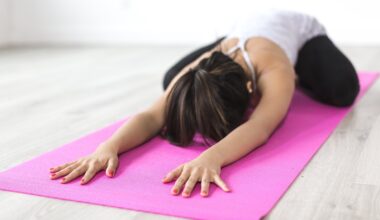Breath Control Tips for Enhancing Yoga Performance
Breath control is an essential aspect of yoga that can greatly enhance overall performance and experience. The practice of controlled breathing, known as pranayama, allows practitioners to refine their focus and deepen their connection with the mind and body. Mastering breath control can lead to increased energy levels and emotional balance, ultimately enhancing one’s yoga practice. When starting out, focus on simple techniques, such as diaphragmatic breathing and equal breathing, to establish a solid foundation. These methods can help you become aware of your breathing patterns and prepare you for more advanced techniques. It’s crucial to practice these techniques regularly, as consistency leads to improvement in one’s ability to control the breath. Additionally, integrating breath awareness into each yoga session can foster a deeper connection with your practice. While moving through poses, maintain awareness of your breath, anchoring your movements with each inhalation and exhalation. By adopting these practices, you will not only support your yoga performance but also cultivate a more mindful approach to your physical and spiritual journey in yoga.
Another fundamental technique to explore is the “Ujjayi” breath, which is commonly used in many styles of yoga, particularly Vinyasa and Ashtanga. This breath technique involves constricting the throat slightly to create an audible sound while breathing, often referred to as the ocean breath. Ujjayi breath can help to increase oxygen intake, enhance focus, and provide a sense of grounding and calmness during practice. To master this technique, start by inhaling deeply through your nose, then exhaling through your mouth while creating the ocean-like sound. Practice this in a seated position before integrating it into your flow. As you progress, aim to maintain this breath throughout your yoga routine, allowing it to guide you through challenging poses. Additionally, understanding the importance of breath retention during yoga, known as Kumbhaka, can greatly impact your performance. It helps to build lung capacity and teaches you to remain calm under stress. As you practice these techniques, remember that breath control is a journey; be patient with yourself and celebrate each small improvement along the way.
Incorporating Breath Awareness into Your Practice
Incorporating breath awareness into your yoga practice creates a deeper connection with the poses and enhances your overall experience. When you become attuned to your breath, you can identify areas of tension in your body and make adjustments accordingly. This can lead to improved alignment and greater ease in difficult poses. To start, set an intention to focus on your breath at the beginning of each session. Choose a simple mantra or affirmation related to breath, such as “I breathe in calm, I breathe out tension.” This can help anchor your practice and serve as a reminder to return to your breath when distractions arise. Throughout your flow, use each inhale to create space and invite energy into your body, while each exhale allows for release and surrender. Consistent practice of breath awareness will allow you to enter a meditative state during your sessions, allowing for greater insight and self-discovery. Remember that being mindful of your breath will enable you to cultivate a calming rhythm that enhances both mental and physical aspects of your yoga practice.
Exploring variations on traditional breath control techniques can enhance your yoga training. Techniques such as Nadi Shodhana, or alternate nostril breathing, are beneficial for balancing the left and right sides of the brain, promoting relaxation, and alleviating anxiety. This practice involves inhaling through one nostril while closing the other and then switching sides. It can be performed prior to or post-yoga practice to enhance focus and serenity. Additionally, learning to synchronize your breath with your movements can transform your practice. This alignment of breath and motion creates fluidity, enhancing your overall flow and grounding your practice. As you explore various styles, such as Kundalini, focus on different ways to control your breath. Each style may emphasize a unique approach to breath control, deepening your understanding of yoga’s diverse practices. Maintaining curiosity and openness to new techniques will allow you to continually expand your breath training toolkit. Engaging with the various depth techniques will contribute to providing a richer yoga experience that embodies movement, mindfulness, and breath awareness. With practice, these techniques will ultimately enhance your performance and personal growth on the mat.
Breathing Techniques for Specific Poses
Understanding the role of breath control in specific yoga poses enhances your overall stability and balance. For instance, during poses like Tree Pose (Vrksasana), focus on deep, slow breathing to maintain centering and focus. Inhale as you root through your standing leg, and exhale when you find your balance. A steady breath can help ease any tension in the body, inviting relaxation in the pursuit of this challenging pose. Similarly, in seated forward bends like Paschimottanasana, utilize deep breaths to release tension and deepen the stretch. As you inhale, lengthen your spine, and as you exhale, fold gently forward. This coordinated breathing method can enhance your flexibility and comfort in poses, allowing for deeper access to your body’s capabilities. Furthermore, during energetic poses like Sun Salutations, coordinate your breath with each movement. Inhale as you reach up, and exhale as you fold forward. Maintaining this connection between breath and movement fosters a seamless flow. Continually integrating breath control into specific poses will refine your practice, promote stability, and facilitate optimal performance on the mat.
The benefits of breath control extend beyond the yoga mat and into everyday life. Cultivating awareness of breath can significantly reduce stress and anxiety, improve focus, and enhance overall well-being. Practicing breath control techniques daily can lead to increased mindfulness and an enhanced ability to cope with challenges. When faced with stressful situations, simply taking a few moments to focus on your breath can quickly reset your mental state. Techniques you’ve practiced in yoga, like diaphragmatic breathing or Ujjayi, can be seamlessly integrated into stressful scenarios or even during daily activities. By inhaling for a count of four, holding for four, and exhaling for a count of four, you can achieve a state of calmness. Incorporating breath control into meditation practices can further enhance its benefits. Regularly setting aside moments for specific breath work can lead to sustaining a peaceful mental state. Furthermore, practicing breath control consistently at home or in daily routines reinforces the equanimity achieved during yoga classes. Remember, the goal of breath control is not only about enhancing performance on the mat but also unlocking greater joy and serenity in daily life.
Conclusion
In conclusion, mastering breath control techniques is crucial for enhancing your performance in yoga. It is essential for creating a deeper connection between body, mind, and spirit. By focusing on various breathing methods such as Ujjayi, Nadi Shodhana, and diaphragmatic breathing, you can refine your awareness and cultivate emotional balance. Integrating breath awareness into each yoga practice will foster a more mindful approach, improving both physical alignment and overall wellbeing. As you explore breathing techniques for specific poses, you will cultivate stability, balance, and comfort. Furthermore, the skills learned through breath control will accompany you into daily life, promoting tranquility and resilience when facing stressor. Remember that practice does not make perfect; it fosters improvement and personal growth, which are intrinsic to the yoga journey. Make a commitment to explore the vast potential that breath control offers, and you will notice significant enhancements in every aspect of your practice. Allow the breathe to lead you on this journey of self-discovery, focusing not only on the poses but also on the power of your breath.
To support your journey, consider exploring additional resources, connecting with experienced teachers, or participating in workshops dedicated to breath control. Remember to embrace the process of learning, and treat yourself with compassion during your practice.


